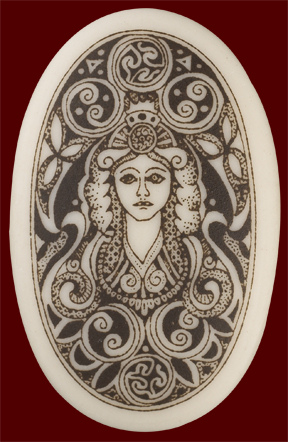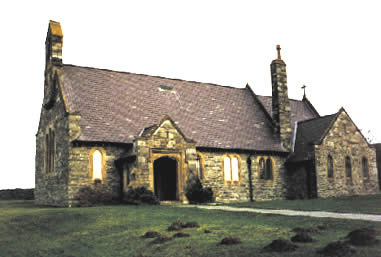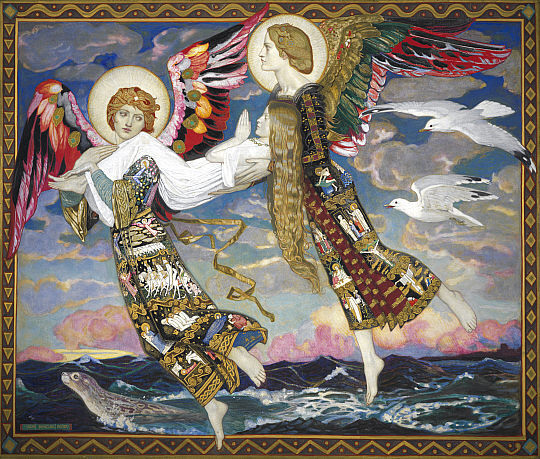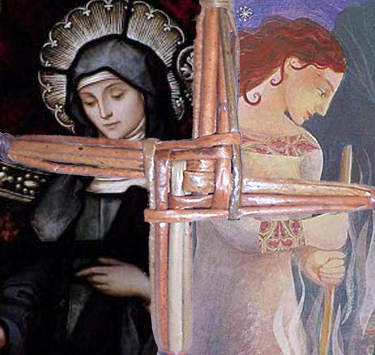Most of us know February 2, as Groundhog’s day. The day that Punxsutawney Phil, that little rodent is trotted out to see if his shadow scares him back into his den. Or, more accurately the day we see if he is still hibernation sleepy. If he goes back in we have 6 more weeks of winter if not, we have longer.
This ritual like so many other things has its origin in ancient practices of wood and farm craft. Before there was Doppler, even before we fully understood weather we still had to plant so we looked to the animals and plants for cues. Things coming out of their dens was one of those cues.
However February 2(or February 1st depending on your chosen practice), is also a Saint’s day. One of my favorite in fact, because it very thinly covers one of the most important female archetype deities. That of the maiden. In this incarnation, called Brighid, re-named by the Catholic Church Bride.
Brighid or Brigit or Bride or Bridhe, though goddess in her own right, is often referred to as an aspect of Danu. Danu is intermingled with Anu who was said to ‘nurse the gods’. Yet She is further reaching than that. Even practitioners of Vodou have adopted Her as the only Caucasian Loa in the form of Maman Brigitte.
Brighid was the Dagda’s daughter. Dagda, called ‘the Good God’ he was portrayed as a pot-bellied, club-waving rampant male – not unlike the Cerne Abbas Giant. He was a renowned lover of the triple battle-Goddess called the Morrighan. His son, Aengus Og, was born to the Goddess Boand (after whom the river Boyne was named). In Scottish folk-lore Angus and Brighid as Bride represent the Summer Lord and Lady.
Brighid was one of three daughters born to the Dagda. All three bore the same name. To one was attributed the powers of healing, to another, smith craft and to the third, craftsmanship. The triplicate became one in She-Whom-We-Call Brighid. In many ways she is the feminine counter-part of Lugh the Ildana – the Master of All Crafts – for under smith craft comes not only the forging of useful and decorative metal work but also that of weaponry. Craftsmanship is also manifest in the inspiration of poets and bards as well as anything creative from childbirth onwards. Fire was attributed to her so she ruled not only the fires of inspiration and the fires of the forge but also the fires of the hearth and so life itself. Even her name is commonly said to originate from fire: breo-aigit means Fiery Arrow, though it may derive from the Sanskrit brahti, meaning ‘High One’.
She had three sons by Tuireann, son of Ogma. They were named Brian, Iuchar and Uar. The four of them murdered Cian, Lugh’s father. Lugh, in his turn brought about their deaths. After the arrival of the Sons of Mils for whom Amergin was bard, Brighid became known as ‘Mary of the Gaels’. And thus, the Mother of Ireland became the darling of the last set of conquerors.

Britain has a similar goddess named Briganita. In the Brigantia aspect she is akin to the Roman Minerva or even to Britain’s ‘Britannia’. In Bath Minerva merged with Brighid to become Sul/Sulis. Sul presides over the curative hot springs of Bath and Brighid, as goddess of healing, has a number of healing wells named for her. Sul is the very heat that causes the springs to be hot. It is easy to imagine her firing-up the forge far below the earth of Bath, to create the necessary energy to heat the curative springs.
Brighid in her renamed state as Bride has had her name given to rivers all over the United Kingdom. In London’s Fleet Street under the present-day church of St. Bride, lies the site of a pagan temple dedicated to Brighid. As the arts are under her sway, it didn’t take long for her to become the patron saint of journalism. Also in London, there is the women’s prison Bridewell which was once a convent – dedicated to St. Bride.
Her head, carved in stone, was anciently held in high esteem and, with the coming of the Christians, was concealed in a dolmen for safety. Later it was recovered and instated in the church of St, Bride of Knockbridge. In 1847 the local vicar took it to another church and it has not been seen since. it is assumed that it was cast into a peat bog. The supposed physical head of the saint was taken to the Holy Land and is now thought to be enshrined in Lumiar, Portugal. A ceremony still practiced, drives cattle past her head presumably either to make them fertile or to purify them. This is exactly the purpose of the Beltane fires, which were also preceded over by some aspect of Brighid.
St Ffraid

St Ffraid, St. Bride in another guise, came to Wales from Ireland. She crossed the sea, not in a boat but on a sod of earth. After landing at Holy Island’s Treaddur Bay the sod became the mound where to this day stand the remains of her church: Capel San Ffraid. Excavations at the large, man-made mound, disclosed a mass burial. Each body had been interned with its head pointing westward, towards Ireland, or to the mystical land beyond the Ninth Wave, Tir na nOg; the Land of Youth or The Blessed Isles where the dead feast awaiting rebirth. As the bodies were all male it was assumed they were battle-slain warriors. It is, however, conceivable that they were monks or devotees of Ffraid. Though the site is not marked on ordnance survey maps it is found on the left as you cross the Four Mile Bridge from Anglesey to Holy Isle.
Like many saints, St Ffraid is said to have plucked her own eyes out in order to make her unattractive to suitor. Once this objective was achieved, she promptly popped them back into their sockets. She managed to perform all the usual sort of miracles and healings as well as turning the Mayor of London into a horse. Oak leaves and acorns were her emblems – which she shares with Bride.
Bride
There was it seems an actual human personage of Bride. Born in 453, her father was the druid, Dubtach, whilst her mother was a Christian Pictish slave. She went to live with her father when considered old enough to serve him for she was considered his property. Later she took the veil to avoid marriage. When St, Brennain visited her, she had been out tending sheep. Coming in she absent-mindedly hung her cloak upon a sunbeam to dry. St. Brennain, unable to mimic her, was somewhat huffy about the whole thing.
Once, having nowhere to feed and water her cow, she begged of a rich man some land. The man asked her how much room she desired. She replied, “As much as my cloak will cover.” Her cloak began to spread and, if not for the interference of an old woman, would have covered; and thereby freed, all of Ireland. That part of the land was held rent-free until recent times when barracks were built on it. The cloak supposedly went to Bruges Cathedral in 1087, taken there by King Harold’s sister. Bride’s shoe is in Dublin at the National Museum of Ireland. Her bag, rosary, bell and sewing equipment she left behind in Glastonbury where presumably, they still reside.
In Glastonbury
St Bride came to Glastonbury in the last twenty years of her life for solitude. The place she chose to live was a low-lying isle called Beckery or Little Ireland where there was a holy spring called St. Bride’s Well. It is now covered over and lies near the area of sheepskin trades. Later a chapel was re-built in her honor, replacing one dedicated to Mary Magdalene. This, like Capel San Ffraid, also stood on a high point, in a field called Chamberlain hill. Excavated in 1887 a burial was discovered beneath the church’s foundations. It was of six people, who again all had their heads westward. It is likely that the legend of St Ffraid was carried to, and purloined by, the monks of Glastonbury. The fields around the church are still said to be called ‘brides’.
As midwife to Mary
 Legend has it, Bride, mysteriously transported to Bethlehem to become midwife to Mary, was also, in Hebridean legend, the foster-mother and wet-nurse to the baby Jesus; hence her presiding over childbirth. According to legend, she placed three drops of spring water upon the brow of the infant, Jesus. This echoes the birth of the Son of Light who has three drops of wisdom placed on his brow. These three drops are the source of the three rays of light or wisdom present in the Druidic symbol, Awen.
Legend has it, Bride, mysteriously transported to Bethlehem to become midwife to Mary, was also, in Hebridean legend, the foster-mother and wet-nurse to the baby Jesus; hence her presiding over childbirth. According to legend, she placed three drops of spring water upon the brow of the infant, Jesus. This echoes the birth of the Son of Light who has three drops of wisdom placed on his brow. These three drops are the source of the three rays of light or wisdom present in the Druidic symbol, Awen.
St. Bride’s Day comes before but is closely tied to Imbolc or Candlemass. The Roman festival in honor of Februa, after whom the month was named, was held at the same time and was one of purification. The candles of Candlemass are lit with the same intention, to purify; mind and spirit. Legends state St. Bride helped Mary present the infant Jesus to a crowded temple. In order to draw their attention, St Bride appeared wearing a head-dress of lighted candles. As a thank-you Mary decreed that St. Bride’s Day would fall immediately before Candlemass. It also shows how important Brighid was and how, as in many post-catholic cultures she was preserved by the people. Indeed in the case of Bride as midwife to Mary, the story says Bride dreamt her way to Bethlehem and on awaking, found her mantle had been transformed into blue with brilliant stars upon it. These are traditionally Mary’s colors thus giving them both ‘Queen of Heaven’ status. Brighid was held so tight in the people’s hearts that the incoming Christians adopted Brighid as another form of Mary or vice versa; much in the same way the Virgin of Guadalupe is accepted into the Mesoamerican traditions.
The Fires of Bride
St. Bride had a perpetual flame burnt in her honor at Kildare, Ireland. Kildare translates to ‘cell (or church) of oak’. The flame supposedly burnt without ash. The flame was put-out in about 1220 and when re-lit, was assumed to have been fed by oak, the ash miraculously vanishing. The flame was finally extinguished following King Henry VIII’s Dissolution of the Monasteries in 1536-40. Depending on which version you read the flame was either burnt in Brigit’s honor or was continued or initiated by St. Bride herself. Either way, on nineteen consecutive days it was tended by a woman and on the twentieth, by Bride herself. Now the spot is marked by one of Ireland’s famous round towers, which stands in the grounds of the present-day’s St. Brigit’s Cathedral. Though the fires of Bride were only tended by nuns, the original double monastery housed men and women which was a great rarity.
Serpent Queen
On St Michael’s Mount there is a carving of St Bride/Brighid milking a cow; a common image of her and one that reflects her goddess alter-ego. St Michael, controller of the land’s dragon/serpent power is equated with St George who was both dragon-slayer and solar hero whilst Bride/Brighid, in Scotland, was dubbed ‘the serpent queen’. At Inverness she was associated with a barrow at Glenelg which was said to have connections with serpent-worship. In fact, St. Bride’s Day, February 1st, was also a day of snake-worship. At Glenelg she was supposed to rise from the said barrow.
Brighid, representing spring would, like Persephone, emerge from the underworld, bringing summer to the land. Snake and dragon power is not just the ley system it is also the power of the land. Brighid would set it aflame, bringing the warmth of the sun, breaking the winter’s potent hold. A Gaelic verse says:
‘Brighid put her finger in the river on the feast day of Brighid and away went the hatching-mother of the cold. She washed her palms in the river on the day of the feast of St. Padriac and away went the birth-mother of the cold.”
St Padriac, who died when the mortal Bride was eight years old, bears the reputation of cleansing Ireland of serpents. Some believe this to be an (unsuccessful) attempt to purge Ireland of Pagan deity worship including that of Brighid. With her image on St Michael’s church does this mean she is stopping the serpent-power from being killed and thus defying St. Padriac? If so, she as Goddess and Michael as Archangel continue to protect the power of the land, sleeping, coiled about the Tor itself. As the serpent sleeps wound-about the World’s Tree as it also lies coiled at the base of the human spine in the tradition of Kundalini, Brighid stands still protecting the creative in all of us as well as giving hope of rebirth of all sorts.


What a rich history that I wasn’t entirely aware of . Intoxicating indeed.
Fascinating. The Virgin Guadalupe came to my mind just before you mentioned her. It’s comforting to think that the spirit of creativity is a woman.
[…] have a great deal of writing to do over the next week so I need all the help and time I can get. Brigid of Ireland sounds like an amazing Woman. More stories on there way with the help of […]
What a superb post! I spend a couple of
minutes on studying, and I am so excited about the advice that I obtained.
It’s really tough to find something precious on that subject.
However, this writer seems to be a real professional since there
is a special personality in his writings.
I’m going to subscribe to his new publications, just not to skip anything.
This post worths its reading.